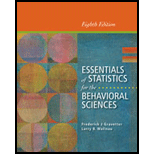
Concept explainers
A local hardware store has a “Savings Wheel” at the checkout. Customers get to spin the wheel and. when the wheel stops, a pointer indicates how much they will save. The wheel can stop in any one of 50 sections. Of the sections, 10 produce 0% off, 20 sections are for 10%off, 10 sections for 20%, 5 for 30%, 3 for 40%, 1 for 50%, and 1 for 100% off. Assuming that all 50 sections are equally likely,
- a. What is the
probability that a customer's purchase will be free (100% off)? - b. What is the probability that a customer will get no savings from the wheel (0% off)?
- c. What is the probability that a customer will get at least 20% off?
(a)
To find: The probability that a customer’s purchase will be free (100% off).
Answer to Problem 1P
The probability that a customer’s purchase will be free (100% off) is 0.02.
Explanation of Solution
Given info:
The information is based on the “savings wheel”. Customer can get to spin the wheel after it stops, a pointer indicates how much they will save.
The wheel have 50 sections. In that 10 produce 0% off, 20 produce 10% off, 10 produce 20% off, 5 produce 30% off, 3 produce 40% off, 1 produce 50% off and 1 produce 100% off.
Calculation:
The formula for probability is,
The probability that a customer’s purchase will be free (100% off) is,
Thus, the probability value is 0.02.
(b)
To find: The probability that the number of sections that a customer’s will get no savings from the wheel (0 % off).
Answer to Problem 1P
The probability that the number of sections that a customer’s will get no savings from the wheel (0 % off) is 0.2.
Explanation of Solution
Calculation:
Calculating the probability that the number of sections that a customer’s will get no savings from the wheel (0 % off) is,
Thus, the probability is 0.2.
(c)
To find: The probability that a customer will get at least 20% off.
Answer to Problem 1P
The probability that a customer will get at least 20% off is 0.40.
Explanation of Solution
Calculation:
The probability that a customer will get at least 20% off is,
Calculating the individual probability values:
For 20:
For 30:
For 40:
For 50:
For 100:
Therefore, the required probability is,
Thus, the probability value is 0.40.
Want to see more full solutions like this?
Chapter 6 Solutions
Essentials of Statistics for the Behavioral Sciences
- Let X be a random variable with support SX = {−3, 0.5, 3, −2.5, 3.5}. Part ofits probability mass function (PMF) is given bypX(−3) = 0.15, pX(−2.5) = 0.3, pX(3) = 0.2, pX(3.5) = 0.15.(a) Find pX(0.5).(b) Find the cumulative distribution function (CDF), FX(x), of X.1(c) Sketch the graph of FX(x).arrow_forwardA well-known company predominantly makes flat pack furniture for students. Variability with the automated machinery means the wood components are cut with a standard deviation in length of 0.45 mm. After they are cut the components are measured. If their length is more than 1.2 mm from the required length, the components are rejected. a) Calculate the percentage of components that get rejected. b) In a manufacturing run of 1000 units, how many are expected to be rejected? c) The company wishes to install more accurate equipment in order to reduce the rejection rate by one-half, using the same ±1.2mm rejection criterion. Calculate the maximum acceptable standard deviation of the new process.arrow_forward5. Let X and Y be independent random variables and let the superscripts denote symmetrization (recall Sect. 3.6). Show that (X + Y) X+ys.arrow_forward
- 8. Suppose that the moments of the random variable X are constant, that is, suppose that EX" =c for all n ≥ 1, for some constant c. Find the distribution of X.arrow_forward9. The concentration function of a random variable X is defined as Qx(h) = sup P(x ≤ X ≤x+h), h>0. Show that, if X and Y are independent random variables, then Qx+y (h) min{Qx(h). Qr (h)).arrow_forward10. Prove that, if (t)=1+0(12) as asf->> O is a characteristic function, then p = 1.arrow_forward
- 9. The concentration function of a random variable X is defined as Qx(h) sup P(x ≤x≤x+h), h>0. (b) Is it true that Qx(ah) =aQx (h)?arrow_forward3. Let X1, X2,..., X, be independent, Exp(1)-distributed random variables, and set V₁₁ = max Xk and W₁ = X₁+x+x+ Isk≤narrow_forward7. Consider the function (t)=(1+|t|)e, ER. (a) Prove that is a characteristic function. (b) Prove that the corresponding distribution is absolutely continuous. (c) Prove, departing from itself, that the distribution has finite mean and variance. (d) Prove, without computation, that the mean equals 0. (e) Compute the density.arrow_forward
- 1. Show, by using characteristic, or moment generating functions, that if fx(x) = ½ex, -∞0 < x < ∞, then XY₁ - Y2, where Y₁ and Y2 are independent, exponentially distributed random variables.arrow_forward1. Show, by using characteristic, or moment generating functions, that if 1 fx(x): x) = ½exarrow_forward1990) 02-02 50% mesob berceus +7 What's the probability of getting more than 1 head on 10 flips of a fair coin?arrow_forward
 Glencoe Algebra 1, Student Edition, 9780079039897...AlgebraISBN:9780079039897Author:CarterPublisher:McGraw Hill
Glencoe Algebra 1, Student Edition, 9780079039897...AlgebraISBN:9780079039897Author:CarterPublisher:McGraw Hill Algebra: Structure And Method, Book 1AlgebraISBN:9780395977224Author:Richard G. Brown, Mary P. Dolciani, Robert H. Sorgenfrey, William L. ColePublisher:McDougal Littell
Algebra: Structure And Method, Book 1AlgebraISBN:9780395977224Author:Richard G. Brown, Mary P. Dolciani, Robert H. Sorgenfrey, William L. ColePublisher:McDougal Littell
 Trigonometry (MindTap Course List)TrigonometryISBN:9781337278461Author:Ron LarsonPublisher:Cengage Learning
Trigonometry (MindTap Course List)TrigonometryISBN:9781337278461Author:Ron LarsonPublisher:Cengage Learning
 Holt Mcdougal Larson Pre-algebra: Student Edition...AlgebraISBN:9780547587776Author:HOLT MCDOUGALPublisher:HOLT MCDOUGAL
Holt Mcdougal Larson Pre-algebra: Student Edition...AlgebraISBN:9780547587776Author:HOLT MCDOUGALPublisher:HOLT MCDOUGAL





